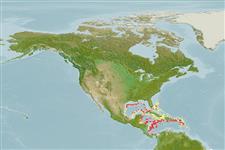分類 / Names
共通名の | 類義語 | Catalog of Fishes(部類, 種) | ITIS | CoL | WoRMS | Cloffa
メクラウナギ (hagfishes) >
Myxiniformes (Hagfishes) >
Myxinidae (Hagfishes) > Eptatretinae
Etymology: Eptatretus: hepta (Gr.), seven; tretos (Gr.), perforated (i.e., with holes), referring to seven gill apertures on what would later be described as Homea banksii (=E. cirrhatus) [range within genus is 6-14 pairs of gill apertures]. (See ETYFish); mendozai: In honor of Luis H. “Uchy” Mendoza, captain of the research vessel Crawford from which holotype was collected, for his “experiential knowledge and academic curiosity of the sea, without whose determination and nautical wisdom” the author would never have discovered this hagfish. (See ETYFish).
Environment: milieu / climate zone / depth range / distribution range
生態学
海 深海魚; 移住性ではない; 深さの範囲 720 - 1100 m (Ref. 31276). Deep-water
Western Atlantic: Caribbean Sea.
サイズ / 重さ / 年齢
Maturity: Lm ? range ? - ? cm
Max length : 45.0 cm TL オス/雌雄の選別がない; (Ref. 31276)
簡単な記述
検索表 | 形態学 | 形態計測学
Gill apertures 6. Slime pores: prebranchial 13-15; branchial 5-6; trunk 45-48; tail 12-15; total 77-82.
Life cycle and mating behavior
Maturities | 繁殖 | Spawnings | Egg(s) | Fecundities | 幼生
Copulatory organ absent. The gonads of hagfishes are situated in the peritoneal cavity. The ovary is found in the anterior portion of the gonad, and the testis is found in the posterior part. The animal becomes female if the cranial part of the gonad develops or male if the caudal part undergoes differentiation. If none develops, then the animal becomes sterile. If both anterior and posterior parts develop, then the animal becomes a functional hermaphrodite. However, hermaphroditism being characterised as functional needs to be validated by more reproduction studies (Ref. 51361 ).
Fernholm, B., 1998. Hagfish systematics. p. 33-44. In J.M. Jørgensen, J.P. Lomholt, R.E. Weber and H. Malte (eds.) The biology of hagfishes. Chapman & Hall, London. 578 p. (Ref. 31276)
Human uses
用具
特記事項
XMLをダウンロードして下さい
インターネットの情報源
Estimates based on models
Preferred temperature (Ref.
123201): 5.6 - 8.2, mean 6.7 °C (based on 18 cells).
Phylogenetic diversity index (Ref.
82804): PD
50 = 0.5000 [Uniqueness, from 0.5 = low to 2.0 = high].
Bayesian length-weight: a=0.00204 (0.00092 - 0.00452), b=2.93 (2.73 - 3.13), in cm total length, based on LWR estimates for this (Sub)family-body shape (Ref.
93245).
栄養段階 (Ref.
69278): 4.1 ±0.7 se; based on size and trophs of closest relatives
回復力 (Ref.
120179): 低い, 4.5年~14年の倍増期間の最小個体群 (Fec assumed to be <100).
Fishing Vulnerability (Ref.
59153): Low to moderate vulnerability (35 of 100).
